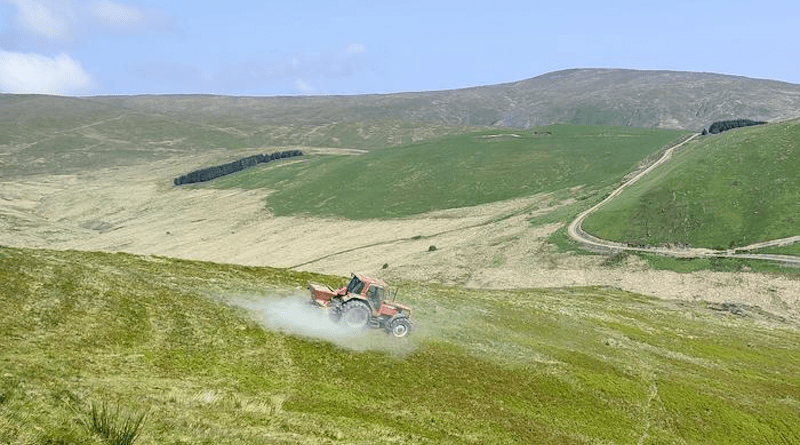Trials Will Investigate If Rock Dust Can Combat Climate Crisis
Scientists at the UK Centre for Ecology & Hydrology (UKCEH) are trialling an innovative approach to mitigating climate change and boosting crop yield in mid-Wales. Adding crushed rock dust to farmland has the potential to remove and lock up large amounts of carbon dioxide from the atmosphere.
In the first trial of Enhanced Rock Weathering on upland grasslands in the world, UKCEH scientists have applied 56 tonnes of finely ground basalt rock from quarries to three hectares of farmland in Plynlimon, Powys, this month and are repeating this at the same time next year.
The basalt rock dust particles, which are less than 2mm in size, absorb and store carbon at faster rates than occur with the breaking down, or weathering of the naturally occurring rocks at the sites, reducing the timescale from decades to just months (see Notes).
As part of the project, similar trials are also being carried out at lowland grassland in North Wyke, Devon, and arable cropland in Harpenden, which are field sites owned by Rothamsted Research, as part of a wider UK study funded by UK Research and Innovation (UKRI).
The project is led by Professor David Beerling of the University of Sheffield, who estimates that Enhanced Rock Weathering could remove up to two billion tonnes of CO2 a year from the atmosphere globally by 2050. This would include up to 30 million tonnes in the UK – around 30 per cent of annual greenhouse gas removal (GGR) targets* as part of national net zero plans.
While other studies from around the world suggest Enhanced Rock Weathering could be very effective in removing greenhouse gases from the atmosphere, there have been no large-scale trials in the UK for our specific land use and soil systems.
Professor Bridget Emmett, Head of Soils and Land Use at UKCEH, says: “Enhanced Rock Weathering offers multiple potential wins. Rock dust could play a key role in meeting net zero and Paris Agreement targets. Meanwhile, the resulting chemical changes in the soil can also aid crop and grass production.
Critically, the project includes a whole system assessment of emissions linked to the supply and transport of the rock dust from quarries around the UK, to identifying the potential unintended environmental impacts such as changes in freshwater biodiversity.”
Dr Alan Radbourne of UKCEH, who is managing the Plynlimon trials, says: “We hope to understand more of the scale and possible trade-offs this technology might have in the real world. However, the magnitude of climate crisis means that it will be just part of the broad mix of nature-based and engineered solutions needed to accelerate greenhouse gas removal. It is also important to remember we need to significantly reduce our emissions in the first place.”
UKCEH, which has been researching biogeochemical and hydrological processes in the Plynlimon catchments since the 1960s, has set up greenhouse gas flux chambers on the fields to measure how much carbon dioxide and other greenhouse gases are captured from the atmosphere. Our scientists will also monitor the amount of carbon stored in soil and transferred to the river, as well as other impacts on biodiversity, grass production and overall water quality. Time-lapse cameras are being used to monitor sheep grazing patterns in the catchment to see if changes in the forage quality will draw more sheep to the area.
*In its Balanced Net Zero Pathway of its Sixth Carbon Budget, the Climate Change Committee estimated a total of 97 million tonnes of CO2 year, from engineered and land-based solutions, would be required to be removed from the atmosphere by 2050 as part of the UK’s net zero target. A report by Element Energy and UKCEH, commissioned by BEIS, produced a range of combinations of GGR methods that could remove 110 million tonnes a year.

